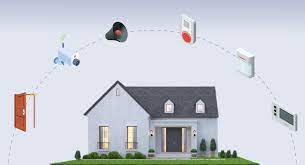Home security is a top priority for homeowners, and advancements in technology have made it easier than ever to monitor and protect your property. One such technology that has revolutionized home security is the Internet of Things (IoT). In this article, we’ll explore the concept of home security and surveillance with IoT, including its benefits, types of devices, and best practices for implementation.
Understanding IoT Security Systems
IoT security systems utilize interconnected devices and sensors to provide comprehensive surveillance and monitoring capabilities for your home. These systems typically consist of smart cameras, motion sensors, door/window sensors, and other IoT devices that communicate with each other and with a central control hub.
Benefits of IoT Security Systems
One of the primary benefits of IoT security systems is their ability to provide enhanced monitoring capabilities for your home. With live video feeds and real-time alerts, you can keep a watchful eye on your property from anywhere, at any time. Additionally, IoT security systems offer remote access and control features, allowing you to arm/disarm your system, adjust settings, and receive notifications directly from your smartphone or tablet.
Types of IoT Security Devices
There is a wide range of IoT security devices available on the market, each serving a specific purpose in enhancing home security. Smart cameras and video doorbells provide visual surveillance, while motion sensors and window/door sensors detect movement and unauthorized entry into your home.
Integration with Smart Home Systems
One of the key advantages of IoT security systems is their seamless integration with existing smart home devices and systems. Whether you have smart lights, thermostats, or locks, IoT security systems can be easily integrated to create a cohesive smart home ecosystem. This integration allows for automation and customization options, such as setting up rules and schedules for device operation.
Choosing the Right IoT Security System
When selecting an IoT security system for your home, it’s essential to consider factors such as your budget, desired features, and scalability. Some systems offer DIY installation options, while others may require professional installation for optimal performance. Researching different systems and reading customer reviews can help you make an informed decision.
Installation and Setup Process
The installation and setup process for IoT security systems vary depending on the manufacturer and model. DIY systems typically come with step-by-step instructions and online tutorials to guide you through the process. For more complex systems or if you’re unsure about the installation process, professional installation services are available.
Best Practices for IoT Security
To ensure the security of your IoT devices and protect your home from potential threats, it’s essential to follow best practices for IoT security. This includes regularly updating your device’s software and firmware to patch any vulnerabilities, implementing strong password protection for your network and devices, and enabling encryption protocols for data transmission.
Conclusion
In conclusion, home security and surveillance with IoT offer a convenient and effective way to monitor and protect your property. By leveraging interconnected devices and advanced technology, IoT security systems provide enhanced monitoring capabilities, remote access and control features, and seamless integration with existing smart home systems. Investing in an IoT security system is a proactive step towards safeguarding your home and providing peace of mind for you and your family.
